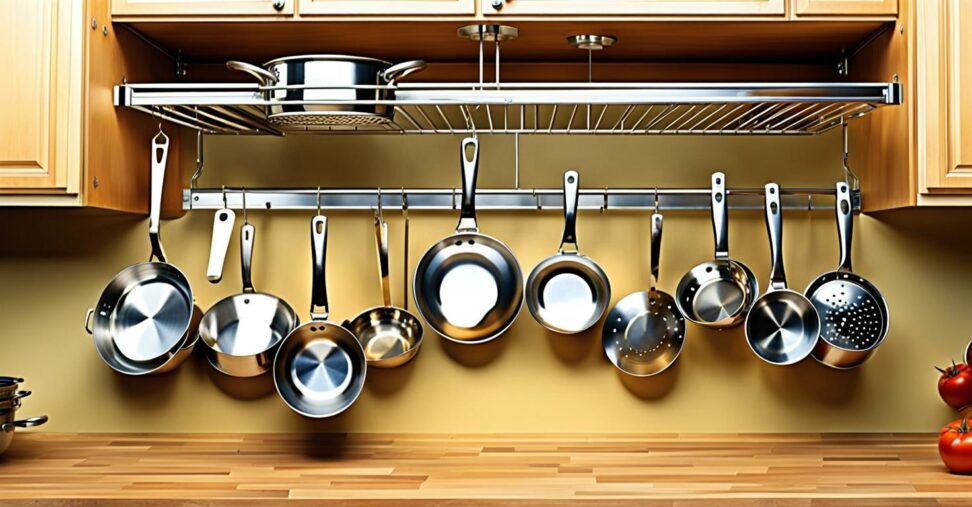The Complete Guide to Hanging Pots and Pans in Your Kitchen
Having pots, pans, and other cookware easily accessible while you're cooking makes a huge difference in preparing meals efficiently. But dealing with cluttered cabinets jammed full of bulky pots and pans can be frustrating. Hanging your pots and pans is an excellent storage solution to free up cupboard space and keep your essential cookware visible and within reach.
Hanging Pots and Pans Frees Up Storage Space
Finding adequate kitchen storage can be a challenge, especially for small kitchens. Cabinets and drawers fill up quickly, forcing you to stack pots awkwardly or shove pans far back on shelves.
Hanging pots and pans clears out prime cabinet space for food and other essentials. By storing pots, pans, and lids vertically, you maximize unused vertical real estate. Hanging your cookware high opens up the lower cabinets for easier access to everything else.

Maximizes Vertical Space
Most standard kitchen cabinets only utilize the lower half of available vertical space. Hanging pans and pots high on walls or from ceilings completely maximizes the vertical dimension.
This added overhead storage capacity is ideal for small kitchens. When floor space is limited, utilizing vertical space efficiently creates more usable storage.
Creates More Usable Countertops
Pots and pans piled on the counter take up valuable real estate. This forces you to work around them, limiting your food prep area.
Hanging cookware opens your counters for the prep space they were intended for. With your most-used pots and pans overhead within arm's reach, the countertop can be kept clear.
Types of Racks and Hangars for Pots and Pans
From wall-mounted racks to pan hooks, there are many hanging storage solutions for getting pots and pans off counters and out of cabinets. Consider your kitchen layout, cookware, and style preferences when deciding which option works best.
Wall-Mounted Racks
Wall-mounted pot racks screw securely into walls to hold pots and pans horizontally. Racks come in various materials like black iron, stainless steel, bronze, chrome, and wood.
Styles include single row racks, double hanging racks, and triangular racks. Make sure to hit studs and follow weight limits when mounting. Position them at a convenient height for access while cooking.
Ceiling-Mounted Pot Racks
Hanging from ceilings on chains, ceiling-mounted pot racks provide overhead storage. Consider the weight the ceiling can hold and recommended heights between 18"-30" above countertops.
Ceiling racks can hang mid-kitchen or over islands. Have adequate vertical clearance and watch for ceiling beams or lights when positioning.
Pot Racks
Freestanding pot racks provide hanging storage without mounting on walls. Materials like wrought iron, wood, or stainless steel hold pots while taking up minimal floor space.
Search for pot racks in various sizes with features like wheels for mobility. Place them nearby for cooking access or where they're easily visible.
Pan Hangers
Pan hangers are Individual hooks that mount on walls or underneath cabinets to hold single pans. Hanging pans separately allows you to maximize space versus traditional racks.
Choose from mountable versions or hanging rails with movable hooks. Use multiple hangers evenly spaced for a seamless look.
Wall Hooks
Basic screw-in wall hooks and rails can be installed to hang anything from pots and pans to utensils. Position them slightly above countertops for easy access.
Space hooks evenly and check weight capacities to prevent pulling out of the wall. Stagger items for optimal use of space.
Wall Shelves
Wall-mounted shelves or floating ledges can provide subtle storage for pans and lids. Opt for solid shelves that can handle cast iron or other heavy pans.
Install as a focal point or group multiples. Include lips or edges to keep items from sliding off open shelves.
Arrangement and Placement Tips
Proper arrangement and placement of your hanging pots and pans ensures both visual appeal and cooking function. Keep these tips in mind when installing your racks.
Arrangement by Use and Weight
Consider how often you use particular pots when deciding where to place them. Position everyday pans and pots within easy reach.
Heavier cast iron and stock pots should go near the bottom with lighter items up high. Aim for balanced distribution.
Optimal Placement in the Kitchen
Locate racks near the stove for convenient access while cooking. Wall-mounted racks do well above the peninsula or island for visibility.
Avoid hanging pans directly above the sink or range to prevent water damage or grease build up.
Hanging pots and pans is an excellent kitchen storage solution. The various rack, shelf, and hanger options available let you maximize vertical space while keeping cookware visible and within reach.
Follow the tips on placement and arrangement in this guide to select the hanging method that works best for your kitchen layout and cooking needs.